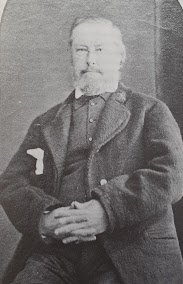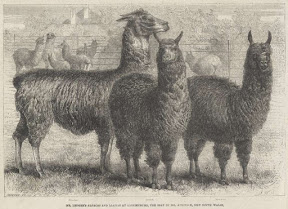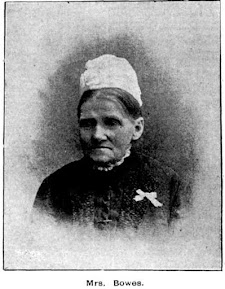A man ahead of his time
Summer in Australia and it's the right time for a cooling gin and tonic and in winter there is nothing more cosy than a blanket made of alpaca wool. Today's blog is about a man who is associated with both these things.
CHARLES LEDGER
Charles was born in March 1818 in Bucklesbury, east London, the son of George Ledger, a mercantile broker, and his wife Charlotte. In 1836 he set sail for Peru and became a clerk in the British merchant's office in Lima. Whilst there he rescued a drowning native Manuel Mamani who offered to become Ledger's servant for saving his life.
In 1848 Ledger began to breed alpacas and by 1850 he became interested in supplying alpacas to the colony of NSW in the hope that the introduction of these animals would be as successful as the merino sheep industry. He visited Sydney in 1853 and conferred with Governor FitzRoy and others who confirmed that it was a viable concern, and it was later claimed by Ledger that he had been promised a grant of 10,000 acres in return for the introduction of 100 alpacas. Unfortunately, Ledger failed to have a written guarantee of this.
Charles Ledger - Ancestry.com
The export of alpacas from Peru was prohibited and many people suffered if they attempted to ship them anywhere. Ledger's second in command was killed for his part in the activity. Ledger took 5 years collecting the animals secretly and was twice imprisoned and constantly in trouble with the authorities as he drove the flock more than 2,500 kilometres to Copiapo which he reached in 1858. From there he sailed to Sydney and arrived 4 months later with 274 animals that initially grazed in the Domain. The Government purchased the flock for £15,000 and moved the alpacas to Goulburn. Ledger became Superintendent of the flock, but Governor FitzRoy was no longer in office and there was no land grant. Commercial interest waned as the wool industry viewed competition as worrying and the animals were seen to be rather strange looking beasts. The budding alpaca industry collapsed.
Ledger returned to Peru to commence a further venture, also of another prohibited export from the country. Whilst Ledger was in Australia, his servant, Manami, had spent 4 years collecting cinchona seeds from which quinine was extracted. Quinine controlled malaria fever and was what made it possible for Europeans to work in tropical climates. Ledger managed to get some seeds out of the country but the British Government refused to buy them however the Dutch Government bought a small amount which was successfully cultivated in Java. Plantations of the species provided much of the world's quinine from 1900 to 1940.
Cinchona - Wikipedia
The Dutch paid only £100 for the seed alone and once again Ledger was in financial loss. In 1871 Mamani was arrested on a seed hunting trip and beaten so severely that he died soon afterwards. Ledger was deported from Peru and lived in Argentina and Uruguay before returning to Australia and acquiring a farm near Goulburn. He then lost his savings in the banking crisis of the 1890's. The Dutch government finally provided a lifeline paying an annuity of £100 from 1897 over thirty years after he had provided the seeds for their now booming industry.
Charles Ledger died in his home, Mimosa, Elswick Street, Leichardt in 1905 suffering from senile decay. He was survived by three daughters; his first wife, a South American had died in Peru in 1857 and his second wife Charlotte, whom he had married in 1860, died in 1891. He was buried in the independent area of the Cemetery. A monument stating, "He gave quinine to the World" (now a little hard to read) was placed on his grave in the early 1980's as a result of findings by a World Health Organisation official visiting Australia that Ledger was lying in an unmarked grave. Funds were raised from a Dutch quinine manufacturer to pay for the monument.
Charles Ledger monument - author's own collection
Charles Ledger monument close up - author's own collection
Charles Ledger took considerable risks to bring South American discoveries to the world but was thwarted constantly perhaps by basing too much in the trust of others and losing a great deal financially.
I believe if he could only have foreseen that his seeds that were the foundation of the quinine industry in Java would end up back in South America via Australia and replanted in Guatemala, their native continent, he would have been greatly amused. Besides the outstanding health benefits regarding malaria, quinine also assists in easing night-time leg cramps.
Charles, I'm sure, would be impressed by the growing alpaca industry in this country not just fleece but also meat that is now exported overseas. There is an annual Charles Ledger Alpaca Show held in the Southern Highlands of NSW each year.
Charles Ledger was a man way ahead of his time.
For today's blog I have utilised information from Ancestry.com, the Australian Dictionary of Biography, Wikipedia and other sources found via Google,
Every time I have a gin and tonic, I will muse on the fact that the mixer in my drink will stop that mozzie sting doing it's darndest and will eradicate those pesky leg cramps!
I think it's time to get some Alpaca wool and start knitting!
If you have any comments to add to this blog, please do so below or go to the group Facebook page found under
rookwoodcemeterydiscoveries
and comment there or send me a personal message at
lorainepunch@gmail.com








fantastic
ReplyDeleteBit chilly for a G & T at the moment but come summer I might just change my mind!
Delete